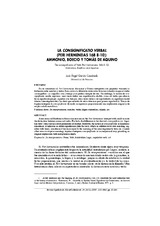La Consignificatio verbal(peri hermeneias 16b 8-10): Ammonio, Boecio y Tomás de Aquino
The Consignificatio of Verb (Peri hermeneias16b 8 -10): Ammonius, Boethius and Aquinas
Autor
García Cuadrado, José Ángel
Editor
UCOPressFecha
2012Materia
De interpretatione,Nombre
Verbo
Lógica aristotélica
Cópula
Est
Noun
Verb
Aristotelian Logic
Copulative verb
METS:
Mostrar el registro METSPREMIS:
Mostrar el registro PREMISMetadatos
Mostrar el registro completo del ítemResumen
En su comentario al Peri hermeneias Ammonio y Boecio interpretan con pequeñas variantes la distinción entre nombre y verbo. Para ambos la diferencia entre estos términos consiste en que el verbo «consignifica» (o «significa con») tiempo y se predica siempre de otro. Sin embargo, la noción de consignificatio resulta equívoca: unas veces indica una significación añadida (como el verbo que además de su significado propio, significa con tiempo); otras veces viene a ser equivalente a la significación del término sincategoremático (es decir que necesita de otros términos para poseer significado). Tomás de Aquino interpreta la consignificatio de modo no equívoco proporcionando una explicación original y de amplio calado metafísico. Ammonius and Boethius in their commentaries on the Peri hermeneias interpret with small variants the distinction between nouns and verbs. For both, the difference is that the verb consignificat (or “signifies with”) time and is always predicated of another. However, the notion of consignificatio is equivocal: sometimes, it indicates an added significance (like the verb, which in addition to its own meaning, signifies with time); sometimes it becomes equal to the meaning of the syncategorematic term (ie. it needs other terms to acquire meaning). Aquinas interprets consignificatio in an inequivocal way, providing an original explanation with metaphysical depth.

